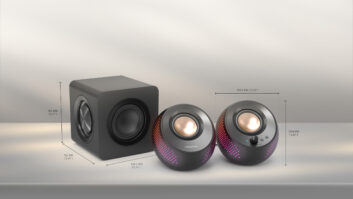Lake Success, N.Y. –
unveiled Tuesday its advanced EOS-1D X pro-level d-SLR.
The advanced camera, which replaces both the EOS-1Ds Mark III and
EOS-1D Mark IV models, is said to combine the advanced image quality of the
EOS-1Ds with the speed of the EOS-1D series cameras.

The EOS-1D X will ship in March 2012 at $6,800 suggested retail
in a body-only configuration.
The EOS-1D X d-SLR is based on an 18-megapixel full-frame Canon
CMOS sensor, Dual DIGIC 5+ imaging processors, 14-bit A/D data conversion and
can shoot up to 12 fps.
The camera introduction coincides with Canon’s celebration of the
50 millionth EOS-series SLR camera milestone, which was achieved last month,
and will soon be joined by the 70 millionth EF-series lens milestone at the end
of October.
“The EOS-1D X represents the re-invention of the EOS-1Ds and
EOS-1D series, combining new proprietary Canon technologies with the
culmination of customer feedback and requests from the field. We are proud to
introduce this camera to the worldwide community of professional photographers
and cinematographers with the features and capabilities they need to capture
the great moments that display their talent,” stated Yuichi Ishizuka, Canon USA
imaging technologies and communications group executive VP and general manager,
in announcing the new camera.
In total, the EOS-1D X will include three DIGIC processors,
including the aforementioned Dual DIGIC 5+ processors and a dedicated DIGIC 4
for processing metering and AF control. The new DIGIC 5+ processors are said to
deliver 17 times more processing speed than older DIGIC 4-level chip.
The new processor pair provides higher-speed continuous shooting,
lower noise and a significantly better data-processing speed than was possible
in previous EOS-1D models, Canon said.
This allows for advanced features such as in-camera chromatic
aberration correction for various Canon EF lenses, instead of through
post-production software.
Meanwhile, the DIGIC 4 processor includes a 100,000-pixel RGB
metering sensor for enhanced exposure accuracy with color and face detection,
and works together with the camera’s new EOS Intelligent Tracking and
Recognition (iTR) AF.
The 18-megapixel full-frame CMOS image sensor is said to produce
the lowest noise of any EOS digital camera to date. The full-frame
characteristic allows for the use of larger pixel sizes (1.25 microns larger
than those in the EOS-1D Mark IV and .55 microns larger than in the EOS 5D Mark
II) and gapless microlense technology, allowing for greater light capturing
capability, higher sensitivity and less noise at the pixel level.
Low-light images are said to be enhanced even further through the
use of the Dual DIGIC 5+ imaging processors.
The image sensor can be cleaned with a new second-generation Ultrasonic
Wave Motion Cleaning system, utilizing carrier wave technology to remove
smaller dust particles from the sensor.
Additionally, a new fluorine coating on the infrared absorption
glass is now used to help repel dust.
The camera’s ISO range is adjustable from 100 to 51,200 within
its standard range. It can also be pushed to a low ISO of 50 for studio and
landscape work to and to two high settings of 102,400 at H1 and 204,800 at H2, for
applications including law enforcement, government or forensic field
applications.
The new A 61-point high density reticular auto focus system, features
21 focusing points in the central area. They are standard precision cross-type
and effective with maximum apertures as small as f/5.6, depending on the lens
in use.
The center five points are also high-precision diagonal
cross-type points for maximum apertures as small as f/2.8.
All 61 points are sensitive to horizontal contrast with maximum
apertures as small as f/5.6 and 20 of the outer focusing points function as
cross-type points with maximum apertures as small as f/4.0, Canon said.
The system also includes an expanded AF coverage area, superior
focusing precision, low-light sensitivity, and greater low-contrast subject
detection capability compared to earlier EOS AF systems.
All AF functions now have their own menu tab for faster
access. A new AF Configuration Tool
allows for customized setting of tracking sensitivity, the acceleration and
deceleration of tracking subjects, and AF point auto switching, which are all
accessible by the AF menu tab.
A built-in Feature Guide advises photographers on which settings
to use according to subject matter.
Additional options include six AF point selection modes: Spot,
Single Point, Single Point with surrounding four points, Single Point with
surrounding eight points, Zone selection, and Automatic AF point
selection.
The EOS iTR AF system also includes Intelligent Tracking and
Recognition and offers the ability to use Face Detection technology to track
recognized faces in addition to color information.
The EOS-1D X is also the first EOS d-SLR with multiple exposure
capability. The camera can combine up to nine individual images into a single
composite image, with no need for post-processing in a computer.
The camera’s super-high-speed mode increases shooting speeds up
to 14 fps at full 18-megapixel resolution in JPEG mode. The new camera is also
capable of shooting RAW, JPEG or RAW+JPEG at speeds up to 12 fps in One Shot AF
or AI Servo AF for sports photography and other high-speed applications.
HD video recording is enhanced with new compression systems,
including the editing-friendly intraframe (ALL-i) and data-friendly interframe
(IPB) and longer recording capability.
The new CMOS imager is said to reduce video artifacts, including moiré,
and the camera will automatically split movie files when a single file exceeds
4GB for continuous video recording up to 29 minutes and 59 seconds across
multiple 4GB files.
Supported video resolution levels include: 1920-by-1080 24p/30p;
and 720p HD or SD video recording at 50p or 60p.
Manual audio level control that is adjustable before and during
shooting is included.
The camera also includes dual CF card slots.
Canon said it will also offer a new compact wireless file
transmitter WFT-E6A ($600, March) and a wireless GPS receiver model GP-E1
($300, April) to support the camera.













